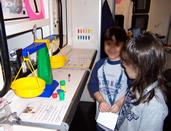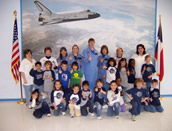| |
|
|
The Micronaut Program
Beginning and Low Readers
Ages 5 to 10
An exciting “space mission experience”
for students ages 5 to 10. Through a series of age- appropriate,
space- and science-related activities, students learn principles
of science, math, engineering, etc., while having fun. The visiting
students are divided by teachers in advance into one to three
teams of up to 18 students each. Each group of 18 students rotates
through a 40-minute Mini Discovery Mission and two 40-minute “Micronaut
EVAs,” for a total of two hours of fun with "science
in space." Up to 54 students total can participate in a Micronauts
mission. See below for an explanation of how groups of students
rotate through the activities.
I. The Mini Discovery Mission
Traveling 240 miles above the Earth’s surface aboard the
International Space Station, the Discovery crew continues the
mission of the largest scientific cooperative program in history.
This elite team of scientists, mathematicians and engineers will
engage in unique research using a variety of hands-on experiments
to learn more about the planet Earth and our solar system. The
highly specialized crew will rotate through a series of short
experiments covering areas including weights and measures, sound
waves, germs, insects and more.
II. Micronauts in Orbit
The Micronauts in Orbit EVA (Extra-Vehicular Activity)
is a hands-on event that addresses the theme of living in space.
Students will participate in the following activities:
• Create their very own STS [Space Transportation System]
model
• Recreate the correct sequence in a real shuttle launch
• Watch a video clip of an astronaut’s daily routine
in space
• Play the "I’m Going To Space" game if
time allows
III. Micronaut Tech
The Micronaut Tech EVA is a hands-on event
that addresses the use of technology.
Students will participate in the following activities:
• Investigate the day and night sky
• Build a Nano Satellite with googolplex parts
• Learn the difference between a telescope and a microscope
• Use a telescope to view distant objects
Group size: Minimum 12 students, maximum
54. For a group of up to 18, the entire group would rotate through
each of the three events above, one event at a time. For a group
of 19 to 36, the students would be divided into two teams, with
each team rotating through the three events in a different sequence.
For groups of 37 to 54, the students would be divided into three
teams, with each team rotating through the three events in a different
sequence. Each event would only be occupied by one group of up
to 18 students at a time.
TOP
|





|